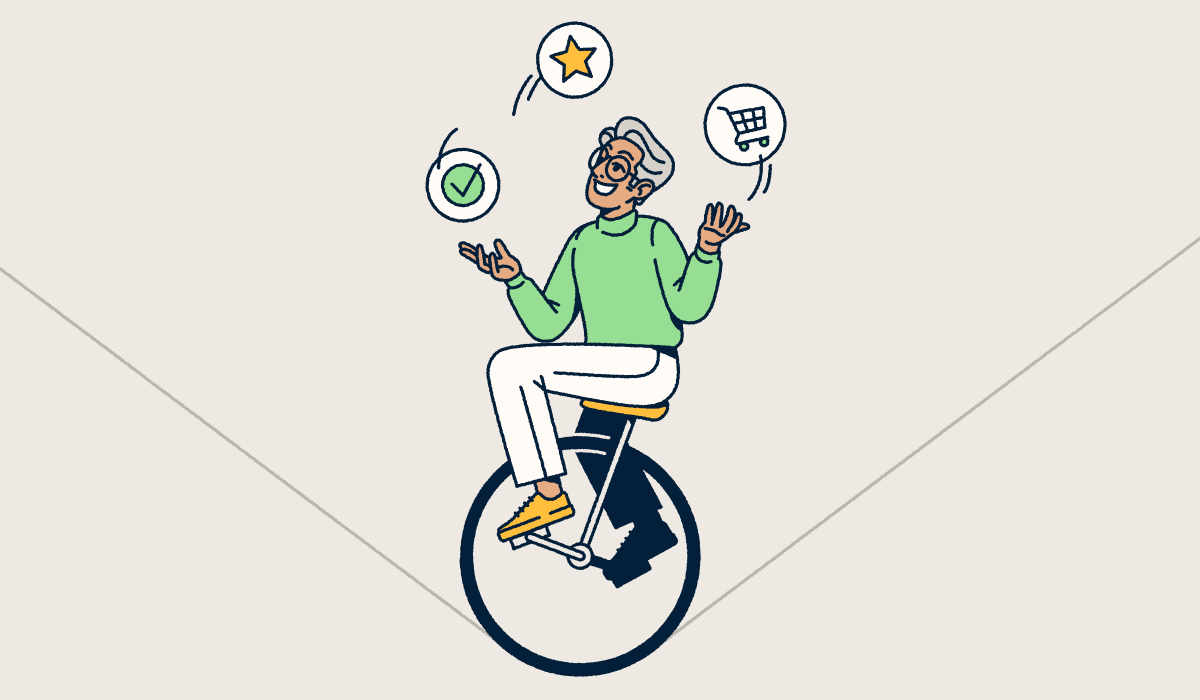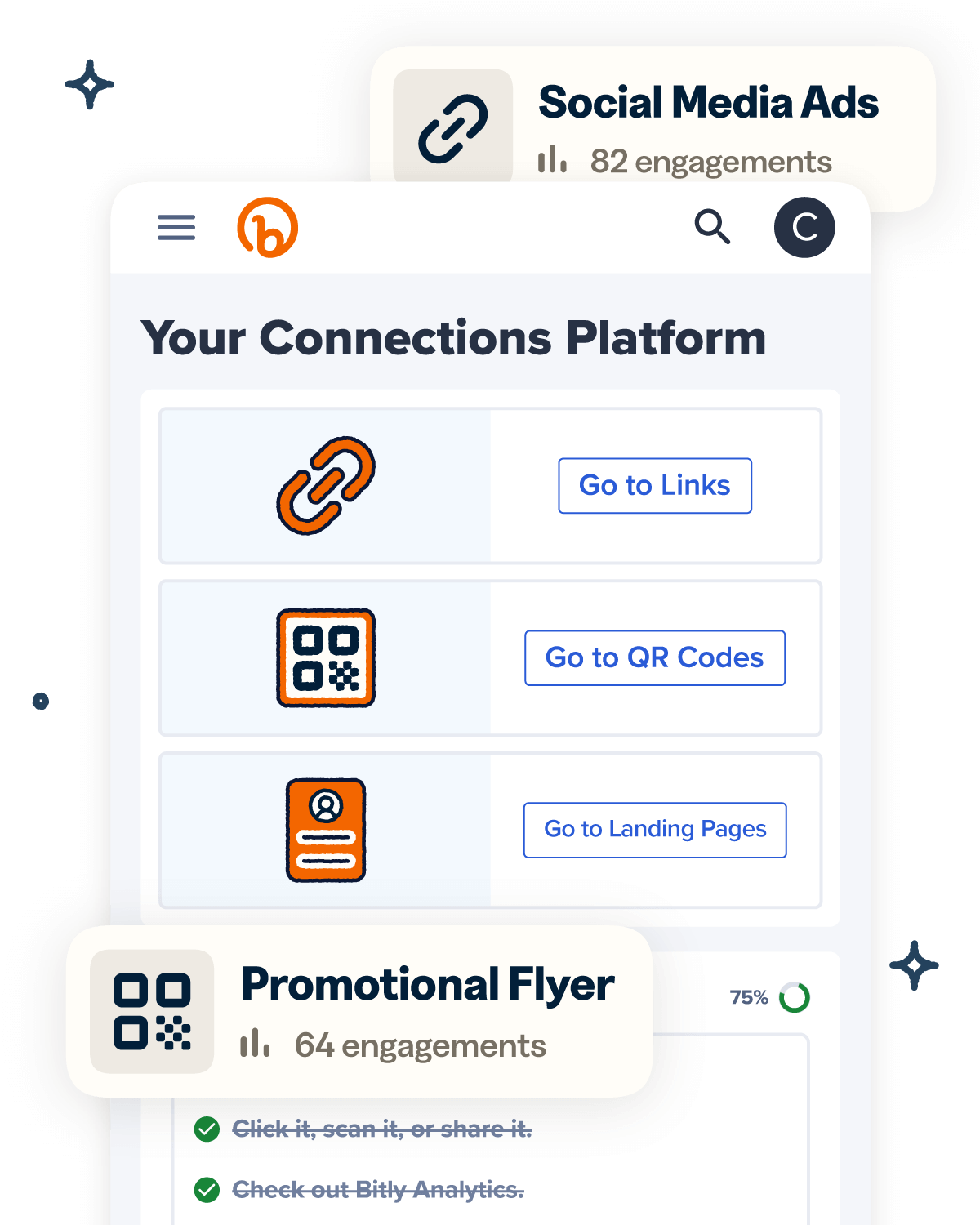Choosing between a landing page and a full website isn’t always straightforward, but it’s a decision that can seriously affect your campaign’s performance. While websites offer depth and broad content, they aren’t always necessary for every marketing goal.
For lean, high-impact marketing campaigns, landing pages can be the smarter move. You don’t always need a full website to develop engaging, mobile-friendly experiences. With our simple tools, it’s easier than ever to create standalone Bitly landing pages that look great, load fast, and drive action.
Whether you’re promoting a product, event, or special offer, these pages offer key differences designed to convert and track results in real time. Bottom line: Less can be more when the right tools are in place. This article explores how.
Note: The brands and examples discussed below were found during our online research for this article.
What’s the difference between a landing page and a website?
A website or homepage is a multi-page experience with navigation menus designed to educate, guide, and showcase a brand’s full digital presence. It’s where visitors explore individual web pages explaining everything from product offerings and company values to blog content, social media links, and support resources.
Websites are essential for building trust, telling a brand story, and helping users find what they need through structured navigation. They’re built for depth, discovery, and long-term ecommerce engagement.
Landing pages, on the other hand, provide streamlined, standalone content built around a single goal—usually conversion. Whether you’re driving loyalty program sign-ups, enabling downloads, or encouraging purchases, landing pages remove the extra noise so users can focus on taking action. With minimal navigation and clear calls to action, they’re optimized for results. Tests have shown that this increased focus can triple conversions.
For savvy marketers, high-converting landing pages are the go-to when every click counts and campaign performance is on the line.
When should marketers use a landing page instead of a full website?
Landing pages are one of the most powerful tools in your toolkit, especially when campaigns demand clarity, speed, and measurable results. Unlike full websites designed for exploration, landing pages encourage action. Here’s when marketers should choose a landing page instead of directing traffic to a full site:
For focused campaigns with one clear CTA
The best landing pages shine when there’s a single goal, like capturing email sign-ups, collecting RSVPs for webinars, or driving product sales. With just one call-to-action (CTA), there’s no confusion about what the visitor should do next. This focus boosts conversion rates and delivers a cleaner, faster experience, especially on mobile.
For users scanning a QR Code on a product or clicking a link in a campaign ad, it’s best to use landing pages to get them to the specific goal faster with less friction.
When speed and simplicity matter
Campaigns often need to launch now, not in a week. Waiting for web teams to update a full website can stall momentum. That’s where the value of landing pages really becomes apparent. They’re perfect for pop-up brand awareness promos, limited-time offers, or A/B testing different CTAs.
Tools like Bitly Pages offer single-page web design templates that let you publish in minutes, and you don’t need to reprint links or QR Codes when you make edits. You can update content on the fly without losing your online presence or interrupting your target audience’s user experience.
To track engagement from print or offline channels
Short links and QR Codes on packaging, signage, or mailers only work if they send users to a site that’s fast, clear, and mobile-optimized. That’s exactly what landing pages offer. They help potential customers understand your message and take the desired action, whether it’s enjoying a discount at your online store or signing up for email marketing.
Bitly Analytics lets you track every interaction, including when users engaged, where they were, and what devices or browsers they used. You can organize campaigns into folders and monitor lead generation performance in real time, with no guesswork required.
When you need a distraction-free experience
Websites have their place, but they’re built for browsing, not to convert visitors. Landing pages strip away the clutter of an entire website—like navigation bars, blog links, and other exits—to keep users focused on just one thing: your CTA.
Whether your goal is for visitors to subscribe to a newsletter, download an eBook, or make a purchase, these single-purpose pages reduce distractions and drop-offs. They’re built for momentum, turning first impressions into rapid responses, without all the noise. Landing page design elements that encourage action keep users focused on your ultimate goal.
When is a full website the better choice?
Landing pages are powerful for quick, focused campaigns—but sometimes, a full website is the smarter, more strategic move. When your audience needs depth, flexibility, and lasting visibility, a well-structured website offers the best foundation. Let’s explore when marketers should choose a full website over a collection of different landing pages.
When users need to explore or navigate
Websites are essential when your audience may want to explore your brand beyond a single message or offer. If users are likely to browse multiple product pages, dive into FAQs, check out your blog, or learn about your company’s mission, an in-depth, multi-page website creates the best experience.
With intuitive menus and internal links, you can guide visitors through multiple paths and deliver the information that matters most to them—something a landing page simply can’t support. For example, a digital agency promoting services for startups, enterprises, and nonprofits would benefit from a website that lets each audience self-select and explore relevant case studies, pricing, and testimonials.
For long-term brand presence and SEO
If you’re looking to establish a strong, long-term digital footprint that reinforces social proof, a full website is the way to go. Brands design websites to rank in search engines for broad and branded terms, building authority over time. They provide ongoing value with evergreen content—like blog posts, service pages, and educational resources—that help drive organic traffic.
Landing pages, in contrast, are typically tied to temporary campaigns and often excluded from search indexing to prevent cannibalizing search results from core pages. A core website acts as your digital HQ, continually attracting new visitors while reinforcing your brand’s credibility and trust.
To support multiple user types or goals
When your brand serves a diverse audience—like donors, partners, customers, and media contacts—a website provides the structure to speak to each group effectively. With dedicated pages and tailored content, each visitor can easily find what they’re looking for, whether that’s a press kit, a partnership form, tutorials, or product demos.
Landing pages, by design, optimize for a single conversion path and audience segment. They don’t offer the flexibility needed to serve multiple goals without overwhelming the user or diluting the message. A nonprofit organization, for example, might use its website to help donors contribute, volunteers sign up, and media outlets access impact reports—all within a unified, user-friendly experience.
How to connect QR Codes and landing pages for better campaign results
Creating a Bitly Page and combining it with QR Codes is one of the fastest ways to drive measurable impact from print, packaging, and other real-world touchpoints in specific campaigns. When used together, these tools give you the power to adapt on the fly, personalize experiences, and track performance down to the scan. Here’s how to get the most out of your campaigns with Bitly:
Use QR Codes for campaign flexibility
QR Codes are no longer just a novelty—they’re a powerhouse for modern marketers who need to stay agile. One of their biggest advantages? The ability to keep the code the same even when the destination page changes. That means you don’t need to reprint flyers, product packaging, or signage every time your promo changes.
Bitly Codes offer this amazing flexibility, letting you update the link behind the code without touching the physical asset. This is perfect for seasonal campaigns, rotating offers, or last-minute pivots.
Example: A consumer packaged goods brand running a summer sweepstakes can launch early with teaser messaging, then swap in the entry form once the promo goes live—no reprints needed.
Track engagement directly from scan to click
It’s simple to group QR-coded short links created with Bitly into campaign folders to give you full visibility into performance. Want to know how many people scanned your signage in New York versus Los Angeles? Or which version of your mailer performed better? With Bitly Campaign tools, it’s all trackable.
To go deeper, marketers can append Urchin Tracking Module (UTM) parameters to each link before shortening it, enabling precise traffic analysis inside platforms like Google Analytics. For high-scale campaigns, Bitly’s Developer API allows teams to automate link creation, standardize UTM tagging, and feed scan and click data directly into dashboards or customer relationship management suites.
Example: A retail chain using location-specific posters can generate region-based QR Codes, monitor engagement by store, and refine messaging based on real-world data.
Build mobile-first landing pages with Bitly
Once a user scans your QR Code, the destination matters. Bitly Pages deliver fast, frictionless mobile experiences that convert. Our landing pages are responsive, simple to create, and focused on a single campaign goal—no coding required.
You can customize branding, update content on the fly, and track how each page performs in real time—even without a website. That’s powerful when paired with QR Codes—especially for product launches, event RSVPs, or special promotions.
Example: A beverage company printing QR Codes on bottles can direct fans to different Bitly Pages depending on the season, featuring new flavors, contests, or exclusive content, without ever changing the physical code.
Make your next campaign faster, clearer, and more trackable with Bitly
When your campaign calls for simplicity, speed, and conversions, landing pages are the way to go, especially when paired with QR Codes or short links. Whether you’re launching a product, promoting a limited-time offer, or driving traffic from print materials, Bitly gives you everything you need in one place.
Create beautiful, mobile-ready landing pages, connect them with branded links or QR Codes, and track every scan and click—all from a single, powerful platform. Plus, you won’t need any dev support! Just fast, focused execution and real-time insights to optimize results.
Ready to launch your next campaign with confidence? Explore our different plans and find the right fit for your team today.


